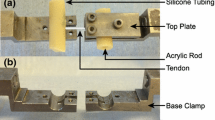Abstract
The mechanical behaviour of horse and human tendon, as characterised by the stress-strain curve, has been examined with respect to load-strain cycling and strain rate. It was found that the tendon stress-strain curve for successive cycles was reporducible provided that strain on the specimen did not exceed 2·0–4·0%. If this strain level was exceeded, a permanent deformation occurred. This phenomenon was verified by histological studies on strained tendon which showed that some of the collagen fibres did not return to their original orientation. Variation in the rate of strain was found to affect both the magnitude and the shape of the stress-strain curve. Additionally, it was found that the stress relaxation phenomenon for tendon was essentially the same as that found for other connective tissues.
Sommaire
Le comportment mécanique du tendon de l'homme ou du cheval, caractérisé par la courbe force-contrainte a été examiné en tenant compte du cycle charge-tension et de la valeur de la tension. Il est apparu que la courbe force-contrainte pour des cycles successifs était reproductible pourvu que la contrainte sur la préparation n'excède pas 2 à 4%. Si ce taux était dépassé, on observerait une déformation permanente. Ce phénomène a été vérifié par des études histologiques sur des tendons étirés: elles ont montré que plusieurs des fibres collagènes ne sont pas revenues à leur orientation primitive. On a trouvé que la variation de la valeur de la contrainte affecte à la fois l'amplitude et la forme de la courbe force-contrainte. De plus en a trouvé que le phénomène de, relaxation pour le tendon était essentiellement le même que celui d'autres, tissues de liaison.
Zusammenfassung
Das mechanische Verhalten von Pferde- und Menschensehnen, wie es in der ‘Stress-Strain’-Kurve (Belastungs-Dehungs-Kurve) charakterisiert ist, wurde hinsichtlich des Belastungs-Dehnungs-Zyklus und der Dehnungsgeschwindigkeit untersucht. Es ergab sich, daß die Belastungs-Dehnungs-Kurve der Sehne über mehrere Zyklen reproduzierbar ist, wenn die Dehnung der Probe nich über 2,0–4,0% hinausging. Wurde dieser Dehnungsgrad überschritten, so stellte sich eine permanente Deformation ein. Dieses Phänomen wurde durch histologische Untersuchungen an gedehnten Sehnen verifiziert; es zeigte sich, daß einige der Kollagenfasern nicht zu ihrer ursprünglischen Orientierung zurückkehrten. Anderung der Dehnungsgeschwindigkeit beeinflußte sowohl Größe als auch Form der Belastungs-Dehnungs-Kurve. Au\erdem wurde festgestellt, daß das Stress-Relaxations-Phänomen für die Sehne im wesentlichen gleich dem bei anderen Bindegeweben gefundenen war.
Similar content being viewed by others
References
Eldon, H. R. (1964) Hydration of connective tissue and tendon elasticity.Biochim. biophys. Acta 79, 592–599.
Elliott, D. H. (1965) Structure and function of mammalian tendon.Biol. Rev. 40, 392–421.
Kenedi, R. M., Gibson, T., Daly, C. andAbrahams, M. (1966) Biomechanical characteristics of human skin and costal cartilage.Fedn Proc. 25, 1084.
Partington, F. R. andWood, G. C. (1963) The role of non-collagen components in the mechanical behavior of tendon fibres.Biochim. biophys. Acta 69, 485–495.
Rigby, B. J., Hirai, N., Spikes, J. D. andEyring, H. (1959) The mechanical properties of rat-tail tendon.J. gen. Physiol. 43, 265–283.
Rigby, B. J. (1964) Effect of cyclic extension on the physical properties of tendon collagen and its possible relation to biological ageing of collagen.Nature, Lond. 202, 1072–1074.
Smith, T. L. (1956) Viscoelastic behavior of polyisobutylene under constant rates of elongation.J. polymer. Sci. 20, 89–100.
VanBrocklin, J. D. andEllis, D. G. (1965) A study of the mechanical behavior of toe extensor tendons under applied stress.Archs. phys. Med. Rehab. 46, 369–373.
Author information
Authors and Affiliations
Rights and permissions
About this article
Cite this article
Abrahams, M. Mechanical behaviour of tendonIn vitro . Med. & biol. Engng. 5, 433–443 (1967). https://doi.org/10.1007/BF02479137
Received:
Revised:
Issue Date:
DOI: https://doi.org/10.1007/BF02479137




